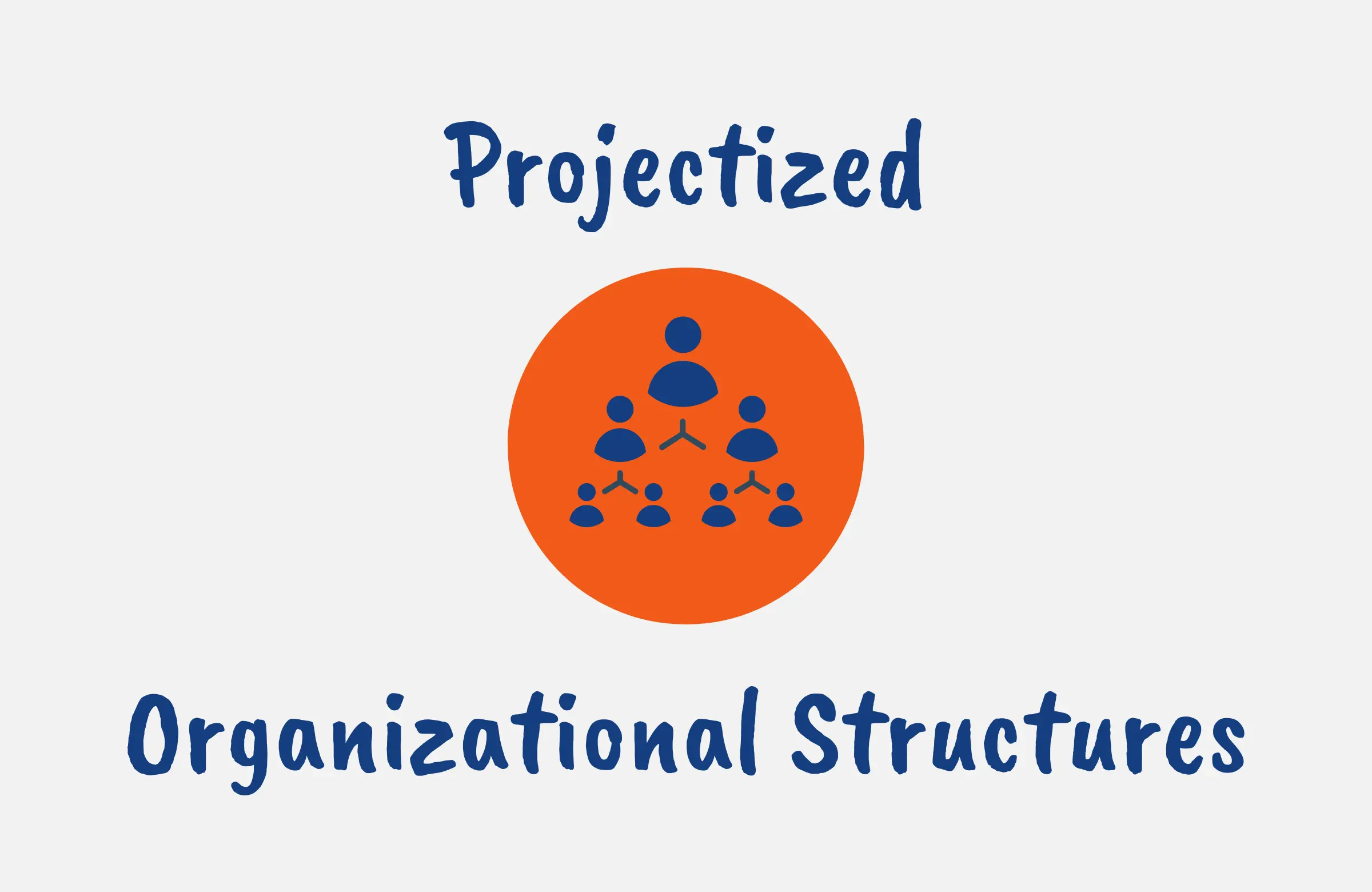Have you ever wondered what a projectized organizational structure is and how it differs from other organizational structures?
In this post, we’ll give you an overview of what projectized organizations entail, their key characteristics, and the pros and cons of this structure.
Whether you’re a project manager trying to decide which structure works best for your team, or just want to learn more about different organizational models, you’ll find this guide on projectized organizations useful.
What is a Projectized Organizational Structure?
A projectized organization is a type of organizational structure that is focused on project work.
Unlike functional organizations where employees belong to specific functional departments, or matrix structures which is a hybrid, projectized structures are optimized for getting work done through projects.
In a projectized organization, employees report directly to project managers instead of functional managers. Resources like staff and equipment are allocated to specific projects rather than functional departments.
The project manager has complete authority over the project team and project resources. Once a project is completed, the team may be restructured or reallocated.
The main purpose of a projectized structure is to focus effort on project deliverables, and it provides a flexible framework for assembling the right expertise, tools, and budget for project work.
The dynamic projectized organization structure is ideal for organizations that work primarily on projects rather than ongoing operations. You can learn more here about the differences between functional, matrix, and projectized organizational structures.

Characteristics of the Projectized Organizational Structure
Here are some key characteristics of projectized organizational structures:
Strong Project Managers
The project manager holds a central role in the projectized organizational structure and has complete authority over the project.
They make all decisions related to the project, lead the project team, and manage all resources while functional managers have little or no role.
Dedicated Project Teams
The composition of the team in a projectized organization is driven by project needs and team members are assigned full-time to work under the project manager.
They report directly to the project manager rather than to a functional manager.
Flexible Allocation of Resources
Resources like staff, equipment, and budgets are allocated on demand depending on project requirements rather than being siloed in functional departments. which enables flexibility in assembling the right resources for each project.
Adaptable Organizational Structure
The projectized organization is structured according to project needs at any given time rather than being arranged by function. The structure can be modified when projects start or end.
Focus on Project Delivery
The sole focus is to complete project work and deliverables. There are few or no internal functional groups involved in operations, and output is measured by project results.
Temporary Team Lifecycle
Project teams are temporary and disbanded after a project ends. Team members are then reassigned to new projects requiring their skills.
Strong Matrix Support
Some administrative functions like HR and IT may be handled by a small functional matrix to support project activities. However functional managers have limited authority.

Advantages of a Projectized Organizational Structure
Adopting a projectized structure offers some key advantages. These include:
Improved Focus on Project Delivery
The sole focus of the project team is to complete the project with no competing priorities which results in faster and more successful delivery of project outcomes.
Clear Authority for Project Managers
Project managers have complete authority over the direction of projects. This simplifies decision-making and execution compared to matrix structures with dual reporting.
Optimized Teams and Resources
Resources like talent and equipment are optimized for each project rather than siloed in departments enabling project managers to assemble the most suitable team.
Enhanced Communication
With no functional managers involved, communication within the project team is faster and direct through a single chain of command which vastly improves collaboration.
Increased Flexibility
The organizational structure can be reconfigured smoothly as projects start and end which provides flexibility to adapt quickly.
Better Project Learning
Team members gain exposure to diverse projects, allowing them to expand their skills. Lessons learned are shared across projects leading to organizational learning.
Reduced Role Conflict
Team members report to only one boss – the project manager. This avoids confusion or conflicts typical of matrix structures with dual reporting relationships.
Motivated Project Teams
Teams are energized and motivated when working on a project from start to finish, with clear objectives and delivery milestones.
Disadvantages of a Projectized Organizational Structure
While projectized structures offer many benefits, it has some potential drawbacks that need to be considered including:
Lack of Functional Expertise
With no dedicated functional units, project teams may lack access to specialized expertise or best practices for specific disciplines.
Overreliance on Project Managers
Too much authority with project managers can sometimes result in dictatorial tendencies or micro-management.
Resource Management Challenges
Juggling resources between projects can be complicated. Project managers must coordinate to balance resource supply and demand.
Project Silos
The focus on individual projects can lead to siloed thinking making knowledge sharing across projects limited.
Stressed Work Environment
The projectized structure can foster high pressure due to tight deadlines which in turn can increase stress and turnover.
Lack of Career Progression
With no permanent functional home, team members may feel they lack career progression and job security beyond the project.
High Recruitment Needs
The organization may need to recruit frequently for project roles since team members are temporary which increases costs.
Matrix Support Limitations
While some functions are matrixed, the lack of full-fledged support groups can create bottlenecks for non-core activities.

How Does a Projectized Structure Provide Agility and Alignment for Project Success?
A projectized structure can provide agility and alignment for project success in a few key ways:
- Flexible Team Assembly: Project managers can build teams with the exact skills and expertise needed for each project providing agility that allows optimized resourcing.
- Adaptable Structure: The organization can restructure smoothly as projects start and end allowing teams to expand or contract based on project needs.
- Clear Authority: With project managers fully empowered, decision-making is streamlined such that there are no delays prevalent with complex matrix structures.
- Single Focus: All efforts are concentrated on project delivery without competing priorities which aligns priorities and prevents diluted focus.
- Motivated Teams: Teams are driven to execute well when working full-time on a project from start to finish. This focus boosts morale and productivity.
- Knowledge Sharing: Team members share lessons across projects leading to organizational learning and facilitating continuous improvement and adoption of best practices.
- Specialized Recruiting: Resources with specialized skills can be acquired for each project rather than developing in-house functional expertise.

Example of Projectized Organizational Structure
Let’s look at a software company that creates customized solutions for clients as an example of a projectized organization.
The company takes on different software projects for various external clients. For each project, a project manager is appointed who assembles a team of developers, testers, designers, etc. based on the project’s requirements.
This dedicated project team works full-time under the leadership of the project manager until the software solution is developed and delivered to the client.
Once the project is completed, the team is disbanded and members are assigned to new projects as needed.
The company has no permanent software development or testing departments and its entire focus is on fulfilling software projects using temporary project teams.
This dynamic resource allocation exemplifies a projectized structure optimized for project delivery.
Conclusion
The projectized organization structure offers a dynamic framework to optimize project execution.
By assembling dedicated teams under empowered project managers, this structure maximizes focus on delivering project outcomes.
While it has some limitations, a projectized approach can be ideal for organizations that work primarily on client projects rather than internal operations or products.
As projects increase in complexity, adopting a projectized structure can provide the agility and alignment needed for project success.
FAQs
Which Role in a Projectized Organizational Structure Monitors a Project Team?
The project manager monitors and leads the project team in a projectized organizational structure.
Who Has the Most Power in a Projectized Organization?
In a projectized organization, the project manager has the most authority and decision-making power over the project team and resources.





